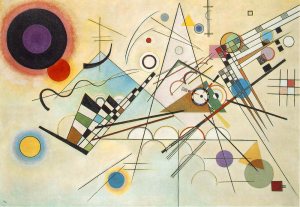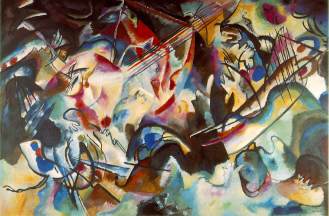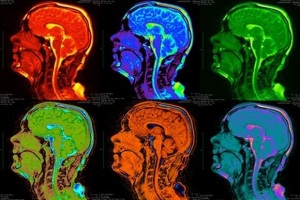“Music has been for some centuries the art which has devoted itself not to the reproduction of natural phenomenon, but rather to the expression of the artist’s soul, in musical sound.” Kandinsky, Concerning the Spiritual in Art
Wassily Kandinsky is considered one of the greatest art philosophers of the XXth century, as he was the first man to produce a theory about abstract art. He was able to do so because he had synaesthesia. For him, sound and colour were intimately related and by representing different forms in a certain way, one could create rhythm. For him, this was not merely to provide an entertainment; both colour and form were meant to create spiritual harmony: pleasure not only for the eyes who look but also for the soul who feels.
Take a look at Composition VI and really consider it with an open mind. What does the explosion of colour that is drawn towards the centre makes you feel? Do you see the violent tension that the use of black lines creates?
Not everyone can see and feel what Kandinsky intended since one must educate the senses and learn to awake feelings through aesthetic experiences. But also, because being synesthetic helps, Kandinsky called this being a “more sensitive soul”. When contemplating a painting, there are two steps: first, the physical impressions; second, the psychic effect: “(Colours) produce a corresponding spiritual vibration, and it is only as a step towards this spiritual vibration that the elementary physical impression is of important.” Kandinsky, Concerning the Spiritual in Art
Kandinsky’s search for spiritual harmony through painting is an important stepping-stone for abstract art, as he was more interested in representing feelings rather than imitating nature. He studied the effects of colour on men, for example the aggressiveness of yellow and the spiritual in blue. He also experimented with lines, as they are the ones that give colour its shape and together they create meaning, a harmonic meaning for the spirit.
Next time you encounter an abstract painting: make your soul listen to its music.
-ana-
Sources:
KANDINSKY, Wassily. Concerning the Spiritual in art. Boston: MFA Publications, 2006. Originally published in 1911.
KANDINSKY, Wassily. Point and Line to Plane. Mansfield: Martino Publishing, 2013. Originally published in 1926.



